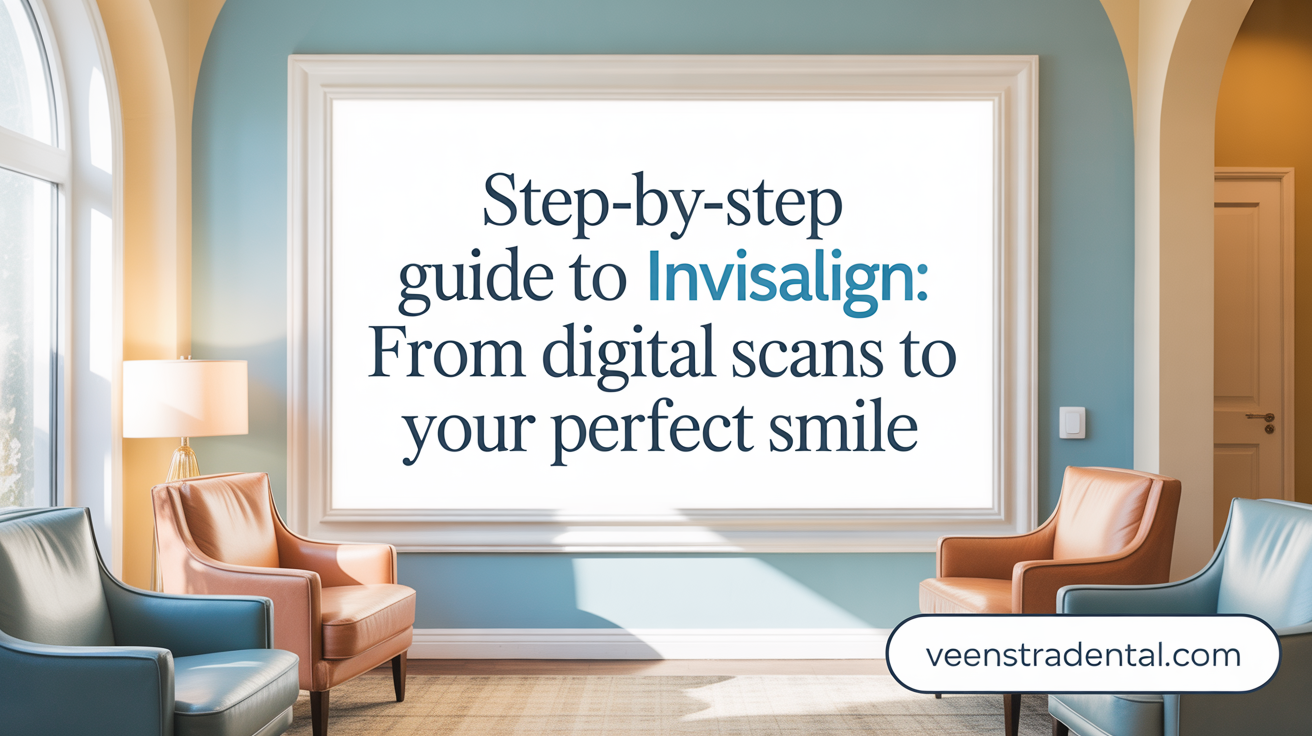Introducing a Modern Approach to a Perfect Smile
In today's world, achieving a perfect smile does not require metal braces or noticeable hardware. Clear aligners, like Invisalign, have transformed orthodontic treatment by offering a subtle, effective, and comfortable alternative to traditional braces. This article explores how these nearly invisible custom-made trays work, their advantages, care requirements, and suitability, guiding readers through the journey to a confident, healthier smile without sacrificing aesthetics or convenience.
How Clear Aligners Work: The Science Behind Subtle Smile Transformation

How does Invisalign work to straighten teeth?
Invisalign achieves teeth straightening through a series of custom-produced, transparent plastic aligners that gently guide teeth into their proper positions. The process begins with a detailed 3D digital scan of the individual's teeth, which allows orthodontists to develop a personalized treatment plan. Using advanced software like ClinCheck®, they map out the precise movements needed over the course of the treatment.
Throughout the process, patients switch to a new set of aligners approximately every two weeks. Each set applies gentle pressure to teeth, gradually shifting them into alignment. Regular consultations ensure progress stays on track and enable adjustments if necessary.
A notable feature of Invisalign is the use of SmartTrack™ material for the aligners. This specially engineered, BPA-free plastic offers a comfortable fit, durability, and a virtually invisible appearance. Once the series of aligners is complete, most patients are advised to wear retainers to preserve their new smile.
Use of advanced 3D imaging and digital modeling
Invisalign employs advanced 3D imaging technology to replace traditional impression methods. Instead of messy, gooey molds, digital impressions are captured using state-of-the-art intraoral scanners like iTero. These precise digital models provide a detailed view of the teeth and bite.
The digital data is then used to create an accurate, customized treatment plan. This process enables orthodontists to visualize the entire treatment journey before it begins, ensuring predictable results and shorter appointment times. Patients can even preview their expected smile transformation virtually.
Custom fit and material of aligners
Each Invisalign aligner is custom-made to fit snugly over the patient's teeth, ensuring comfort and effectiveness. Made from SmartTrack™ material, the aligners are smooth, BPA-free, and durable—designed to withstand daily wear while exerting controlled pressure.
The alignment trays are designed to be nearly invisible and mold perfectly to the contours of the teeth. This personalized approach also minimizes irritation, making the treatment discreet and comfortable.
Step-by-step treatment process and duration
The Invisalign journey begins with a consultation, where oral health is examined, and smile goals are discussed. Advanced digital scans are taken to produce a 3D model, which is then used to craft a customized series of aligners.
Patients typically wear each set of aligners for about 1-2 weeks, removing them only for eating, drinking, brushing, and flossing. Overall treatment duration ranges from 6 to 18 months, depending on the complexity of the case.
Routine check-ups every 6-8 weeks allow the orthodontist to monitor progress and make digital adjustments as needed. After completing the series, a retainer is commonly recommended to help maintain the achieved alignment.
Benefits of Clear Aligners: Comfort, Discretion, and Convenience

What are the benefits and advantages of clear aligners like Invisalign for smile enhancement?
Clear aligners such as Invisalign provide a modern, effective approach to straightening teeth with several benefits over traditional braces. One of the most notable advantages is their discreet appearance. Made from transparent, medical-grade plastic, these aligners are nearly invisible when worn, which significantly boosts confidence during treatment. This discreet feature makes them especially appealing to teens and adults who desire a subtle orthodontic solution.
In addition to being almost invisible, aligners are designed for comfort. Unlike metal braces with wires and brackets that can cause mouth irritation, Invisalign aligners are smooth and BPA-free, gently applying pressure to move teeth without sharp edges. Their removable nature adds further comfort, allowing patients to take them out during meals, which means no dietary restrictions. Patients can enjoy all their favorite foods without worrying about damaging brackets or wires.
Maintaining good oral hygiene is also easier with clear aligners. Since they can be removed, patients can brush and floss thoroughly, reducing the risk of plaque buildup, tooth decay, and gum disease—common concerns with traditional braces. Regular cleaning of the aligners with lukewarm water and a gentle brush helps keep them clear and odor-free.
Overall, Invisalign and similar clear aligners offer a blend of aesthetic appeal, comfort, and practical convenience. They are especially suitable for those seeking subtlety and flexibility in their orthodontic journey. Whether correcting crowding, gaps, or bite issues, aligners provide an effective alternative that fits seamlessly into daily life, making smile enhancement simpler and more pleasant.
Navigating the Treatment Journey: Process, Care, and Patient Commitment

What is the typical process involved in clear aligner treatments and how should patients care for their aligners?
The journey to a straighter smile with clear aligners begins with a thorough initial consultation. During this visit, an orthodontist examines the patient’s oral health, including assessments of teeth, gums, and jaw structure, often utilizing advanced digital technologies like 3D scans and X-rays.
Following the evaluation, a personalized treatment plan is developed. This plan involves creating a precise digital model of the teeth using advanced imaging software, which replaces traditional molds that are often uncomfortable or messy. From this digital model, a series of custom-made aligners are produced. These aligners are crafted from BPA-free, transparent plastic, designed to fit snugly over the teeth.
Patients typically receive a set of aligners to wear for about one to two weeks each. The routine involves wearing them for approximately 20 to 22 hours daily—only removing them during eating, drinking, or oral hygiene practices. Regular check-ins with the orthodontist, generally every 6 to 8 weeks, are essential to monitor progress, make necessary adjustments, and ensure the teeth are shifting as planned.
Proper maintenance of aligners is crucial for successful results. Patients should clean the aligners gently twice daily using a soft toothbrush or aligner cleaner, avoiding harsh chemicals that could damage the material. When not in use, aligners should be stored safely in their case to prevent loss or damage.
Long-term success depends on consistent compliance with wearing schedules, maintaining excellent oral hygiene, and following the orthodontist’s instructions carefully. With diligent care and commitment, most patients see noticeable improvements within a relatively short period, often between 6 to 18 months, leading to a healthier, more confident smile.
Suitability and Effectiveness: Who Benefits Most from Clear Aligners?

Who are clear aligners most suitable for, and are there any limitations?
Clear aligners, such as Invisalign, are primarily designed for individuals with mild to moderate orthodontic issues. These include common misalignments like crooked or crowded teeth, gaps between teeth, overbites, underbites, and crossbites. Teenagers with a full set of permanent teeth and adults in good dental health are the ideal candidates.
Candidates should have healthy gums and teeth, free from major decay or gum disease, which could interfere with treatment. Responsibility and discipline are crucial because aligners need to be worn for about 20-22 hours daily to be effective. Regular cleaning, proper storage, and avoiding eating or drinking (except water) while wearing aligners are important habits for success.
However, Invisalign and similar clear aligners are less suitable for severe or complex issues, such as significant bite problems or extensive restorative dental work. Very young children with ongoing jaw development are generally not ideal candidates.
In cases involving complex dental conditions, traditional braces or other orthodontic methods might be necessary. It’s always best to consult a dental professional who can evaluate individual needs and advise on the most effective treatment options.
In summary, clear aligners work best for those motivated to follow treatment guidelines, with manageable orthodontic issues, and who seek a discreet method to improve their smile.
Managing Challenges and Ensuring Success: Patient Experience and Results
What are the common challenges or complaints experienced by Invisalign users during treatment?
Many Invisalign patients encounter initial discomfort, such as soreness or minor pain, particularly during the first days of wearing new aligners or after switching to the next set. These sensations usually diminish as the mouth adapts. Some may find speaking slightly affected or experience mouth sores and cheek irritation temporarily. Proper oral hygiene is crucial; neglect can lead to cavities, gum inflammation, or bad breath. Damage to aligners from dropping or improper handling is common and can prolong treatment.
Wearing aligners for 20-22 hours daily can be inconvenient, disrupting daily routines and social activities. Some users also face delays if they do not wear aligners consistently or if refinements are needed, which may extend the treatment timeline. Overall, these challenges are manageable and typically resolve with time and proper care.
Why do some people discontinue Invisalign treatment before completion?
A number of patients choose to stop treatment early due to achieving their desired results sooner than expected or feeling discomfort and inconvenience. Unrealistic expectations about the process can also lead to frustration, especially if results take longer or if discomfort persists.
Premature discontinuation can result in incomplete alignment, bite problems, and uneven wear. There's a risk of relapse, where teeth shift back, undoing previous progress. Stopping early may also cause gum and bone issues, affecting long-term oral health. To avoid these complications, it’s essential to adhere to the full treatment plan and consult with the orthodontist before making changes.
What kind of results can patients expect before and after using clear aligners like Invisalign?
Patients typically notice gradual improvements in the alignment of their teeth, culminating in a healthier, more attractive smile. Results depend on initial issues and strict adherence to wearing the aligners. Minor cases can see visible changes within 5 to 8 months, while more complex corrections may take longer.
Invisalign effectively closes gaps, straightens crooked teeth, and corrects mild bite issues. Many report heightened confidence and happiness upon completing treatment, with enhanced smile symmetry and aesthetics. Clinical evidence and real patient photos confirm that Invisalign provides predictable results for adults, teens, and even older patients, making it a reliable choice for a natural-looking, confident smile.
Embrace a Subtle Path to a Healthier, Confident Smile
Clear aligners have revolutionized orthodontic care by providing an effective, comfortable, and discreet way to straighten teeth. Leveraging advanced technology, these nearly invisible devices empower individuals to enhance their smiles subtly while maintaining their lifestyle and confidence. Although best suited for mild to moderate corrections, the comprehensive treatment approach, when followed diligently, offers remarkable results that improve both oral health and self-esteem. Whether you are a teenager or an adult seeking an inconspicuous orthodontic solution, clear aligners present an attractive alternative to traditional braces, proving that perfection can be achieved without compromising subtlety.
References
- The Science Behind Invisalign: How Clear Aligners Move Your Teeth
- How Invisalign Can Revolutionize Your Smile in 5 Easy Steps
- Clear Aligners: The Invisible Path to a Confident Smile
- Straighten Your Smile, Seamlessly: The Advantages of Clear Aligners
- Clear aligner benefits for a confident smile
- SureSmile Clear Aligners: A Comfortable, Discreet Way to Achieve a ...
- The Benefits of Clear Aligners for a Straighter Smile in Des Moines, IA
- The Benefits of Invisalign for Brides-to-Be: Get a Perfect Smile ...
- Achieve a Beautiful Smile in La Mesa Discreetly With Clear Aligners
